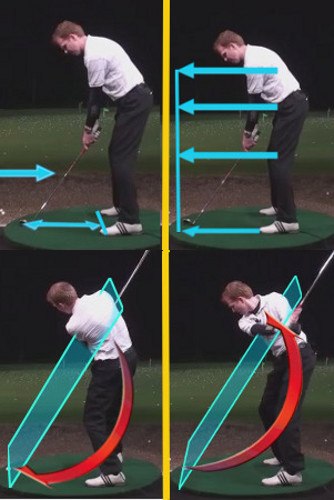
Any left handed golfers who have played golf for a significant period of time will understand that there are very few flat lies on a golf course.
There are innumerable humps, bumps and hollows that must be navigated successfully. One common lie faced during most rounds is an uphill lie. Uphill lies are tricky to tackle because they affect both the swing and resulting ball flight in a number of ways.
Firstly during set up, the spine angle should be adapted to match the slope. This means the spine should tilt away from the target. The greater the angle of slope the greater the spine’s tilt should be. There is a natural tipping effect of body weight which the left handed golfer should be aware of. The more the spine tilts away from the target, the more weight will be placed on the left foot. If this becomes too much, the golfer is in danger of falling down the slope. Although there will be more weight placed on the back foot, left handed golfers should try to keep it as equal as possible between both feet.
This tilting of the spine and slight bias of weight to the back foot is necessary so the club's swing arc (the circular motion traced around the body by the club head) swings up the slope. If a golfer was to set up naturally to the ball on an uphill lie without altering the spine angle, the swing arc would become too steep and cause the club to dig into the ground. Left handed golfers should feel the club follow the slope, brushing the ground just after the ball.
This shallower angle of attack and set up alterations will mean the ball will fly higher than usual. Depending on the severity of the slope, a 7 iron could have its loft increased to something more similar to a 9 iron. This is important because when playing on a windy day, a higher ball flight could be buffeted around in the breeze. Because of the slope, the ball is more likely to leave the club face with a draw ball flight. Again, this is something the left handed golfer needs to take into account. With a draw, they should be aiming more to the left of the target.
During the through swing, the left handed golfer should be aware of one more thing; their weight transfer. Because of the spine tilt and the effect of gravity, the left handed golfer will naturally want to be pulled down the slope. This needs to be resisted because the golfer who stays on the back foot will ‘flick’ the ball upward increasing height and losing distance. To make sure this doesn’t happen, left handed golfers should ensure they move their body weight up the slope, finishing with their weight transferred on to the right foot, hips facing the target and balanced on the left toe.
Although playing shots from sloping lies is difficult, with appropriate preparation before the shot and correct technique during the swing, a positive outcome is achievable.






